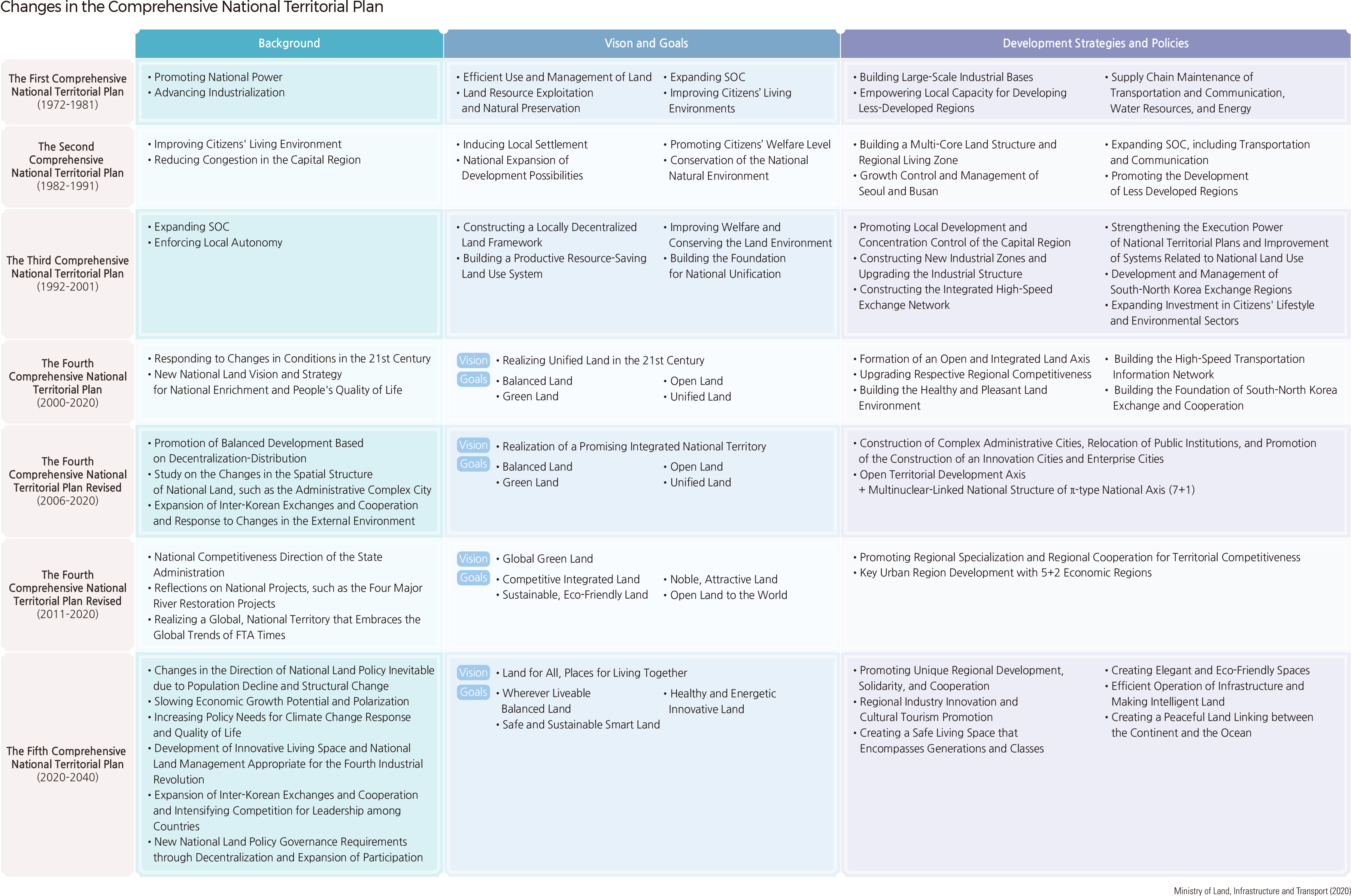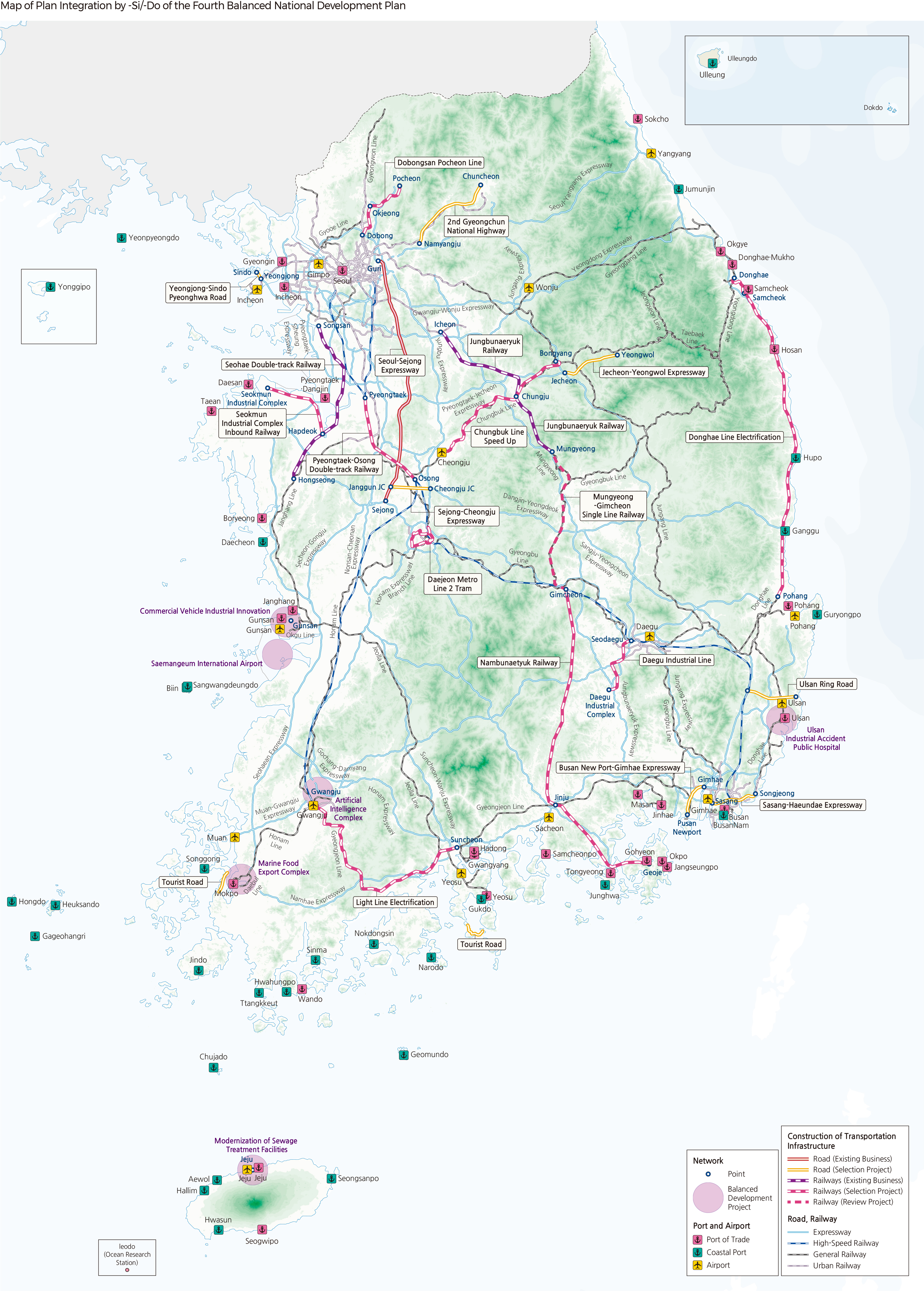English III 2021
The balanced development policy, which adapted from the 2nd Comprehensive National Land Development Plan in 1982, has been a major ideology of the national land development policy. The Five-Year Economic Development Plans that began in the 1960s and the First Comprehensive National Land Development Plan in the 1970s dramatically developed the national economy. However, the disparity in economic development between regions was also large enough not to be ignored. Accordingly, the government has proposed a balanced development policy to develop national territory evenly since the 1980s. Under the goal of “National Expansion of Development Potential,” the 2nd Comprehensive National Land Development Plan aimed to nurture cities around major cities and small and medium-sized local cities across the nation by developing industrial complexes suitable for the size of these cities rather than constructing large-scale industrial complexes in some areas. The plan also built rural-type industrial complexes in provincial cities where the population was expected to decrease and expanded and paved major roads such as national and regional roads. The 3rd Comprehensive National Land Development Plan (1992–2001) in 1992 also continued the balanced development policy. It aimed to develop local cities and rural areas intensively and suppress the industrial concentration in the Seoul Metropolitan Area. In large cities, a wide-area development plan management system was introduced. In small and medium-sized cities, industries suitable for urban characteristics such as manufacturing, tourism, and universities were developed, and convenient facilities such as education, culture, and medical care were expanded. In addition, in order to suppress the concentration of population and economy in the metropolitan area, public institutions were moved to provincial areas, and taxation and financial support were differentiated between the Seoul Metropolitan Area and provincial areas. The 4th Comprehensive National Land Plan (2000–2020) was introduced after the local autonomy was implemented in the 1990s. It was established with the vision of “The Balanced Land where All Prosper Together” and aimed to achieve regional integration through balanced development between regions. This plan established a national supra-economic network of regional axes, with the coastal national axis aiming for international development and the east-west inland axes promoting balanced development. The south inland axis (Gunsan-si and Pohang-si) and the central inland axis (Incheon and Sokcho-si) were set as the east-west inland axes. In preparation for post-unification, a north inland axis (Pyongyang-si and Wonsan-si) was also designated.
In the early 2000s, when the 4th Comprehensive National Land Plan was in progress, balanced national development was enacted into law. In 2004, the first 5-Year Balanced National Development Plan with the subtitle “Regional Innovation Development Plan” was launched. This plan cultivated regional strategic industries and unique local businesses in 16 si/-do areas and developed super-wide clusters between adjacent metropolitan and regional governments. In addition, the central government carried out regional development strategies that fit into the Regional Innovation Development Plans established for each -si/-do area. The title of the Balanced National Development Plan was changed to the Regional Development Plan. The 2nd 5-Year Regional Development Plan (2009–2013) and the 3rd 5-Year Regional Development Plan (2014–2018) were carried out afterward. The 2nd 5-Year Regional Development Plan, reflecting the national policy of 5+2 Economic Region Revitalization, established the following four sectoral plans: the establishment of a 5+2 economic region; the formation of 163 -si/-gun primary living zones; the 4+α mega economic region initiative; and decentralization and regulatory rationalization. The 3rd 5-Year Regional Development Plan suggested regional development policy directions centered on the “Regional Hope (HOPE)” project announced in 2013 to strengthen regional competitiveness and improve residents’ quality of life. This plan created the following six implementation plans: expansion of the local happy living sphere; enhancement of regional economic vitality through job creation; improvement of educational conditions and nurturing of creative talents; thriving of local culture and ecological restoration; establishing welfare and medical care in areas without blind spots; and continued promotion of balanced regional development. In 2018, the title of the Regional Development Plan returned to its original name, the National Balanced Development Plan. The 4th 5-Year National Balanced Development Plan (2018–2022) was announced in January 2019 with the vision of a “Country with a Strong Region, a Balanced Korea.” This plan set decentralization, inclusion, and innovation as the three goals of the national balanced development policy. The key policies to achieve these goals were the promotion of regional-led, decentralized balanced development (decentralization), the progressive restoration of the national balanced development system (inclusion), and the establishment of a foundation for regional-led independent growth (innovation). In addition, the three strategies based on people, space, and industry were adapted: stable and dignified life (people), vibrant space everywhere (space), and regional innovation that creates jobs (industry). |

